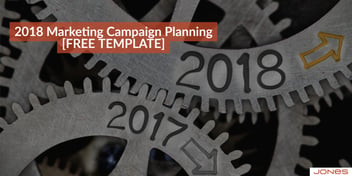Your 7-Step Inbound Marketing Lead Gen Flowchart

The basic concept of inbound marketing sounds simple: create content your audience wants, promote it, convert them to leads, and done!
Except it isn’t that simple. There are multiple steps that the description above—and too many marketers—overlook in their inbound marketing campaigns. This infographic from The Center for Sales Strategy offers a visual overview of the process, divided in seven steps, which matches well with our approach to integrated and inbound marketing, with just a few additions that I’ll address once you have a chance to read through the basics.

Let’s break that down just a little more and give you resources to put each of those steps into motion. (Just FYI – truly implementing inbound marketing isn’t a quick-hit kind of project. Download our HubSpot Implementation Timeline for a realistic approach to creating an inbound marketing strategy that achieves your lead generation goals.)
Step 1: Plan
This infographic is a little optimistic, in my mind, when it suggests an inbound planning DAY. There is a lot crammed into the planning step and you need to get it right. So, let’s break it down. I’m going to group the tasks outlined above in to three distinct areas.
Step 1a: Assess your current needs and set marketing goals
Before you plan your strategy, you need to know both where you are now and where you want to go. That means doing what I call the “data-work.” Gather your current metrics and industry benchmarks to determine what is working now, what needs some minor tweaks and where you are really struggling.
Then, use those benchmarks and your corporate objectives to set goals for your inbound marketing. This means starting with the ultimate goal: revenue. From there, work backward to how many customers you need to achieve that goal; how many leads it takes to get that number of closed deals; how many website visits it takes to convert that many leads; and, finally, what marketing content volume it will take to generate those visits.
Sounds complex, I know, but I walk you through all of the math in a video here: Do the Math to Calculate Marketing Goals. You’ll find more goal-setting tips in this post: First, You Have to do the Data Work.
Step 1b: Develop personas and brainstorm content ideas
I’m grouping these together so that you connect your ideas directly to your audiences. You can create amazing videos, eye-catching infographics and witty blog posts, but if they don’t address the pain points your ideal customers are trying to solve, they won’t convert.
Begin by creating personas that provide an in-depth description of each target buyer or influencer you need to reach. I’ve spelled out 10 questions to answer about each of your personas to help guide content strategy and creation in this blog post: Create a Great Customer Persona. Keep in mind that there may be several, even within similar organizations—you likely need different content to appeal to the CFO than you create for the operations manager or the end user of your product.
Once you have your personas firmly in mind, then is the time to brainstorm the general content ideas that will answer their questions and be at least a first step toward solving their relevant challenges—in other words, addressing the things that are keeping them up at night AND sending them to their computer or phone’s search bar looking for answers.
Step 1c: Develop a content marketing strategy
I’ll include defining responsibilities within this sub-step. The strategy should work with the data you collected and the goals you defined in Step 1a to outline what types of content you will create, with what frequency, targeting which personas and levels of the sales funnel, and who will be responsible for each aspect.
I would even take it to the level of planning out the first year of campaigns (we have a calendar template for that, no need to create your own—Campaign Planning Calendar Template). Define the broad topic of each campaign, which audience it should reach, what specific content pieces you will create and how you will distribute them to reach your audience.
Step 2: Create
Only after the planning is complete do you begin creating. Otherwise, it’s a little like leaving your driveway for a road trip without knowing which direction you need to go. You’ll end up off track and waste gas finding your way back to the right route—Google Maps won’t help you out here.
As part of your planning, you should have already identified which content formats to use to reach your audience. Multi-channel campaigns are most effective when you develop multiple content formats from the same message, maximizing your return on the time spent while also ensuring a consistent message across channels.
There are too many details regarding best practices for each of the possible channels listed in the infographic to go into that in this post, but you’ll find plenty of inspiration and guidance elsewhere in the blog. Here are a few links to get you started:
-
Blogging: How to Plan Your Business Blog Calendar
-
Videos: Secrets for Video Marketing Success: What West & JONES Did Right
-
Podcasts: Adding Multimedia Options to Your Content Marketing
-
Reports, whitepapers and ebooks: Use Surveys & Original Research to Fuel Content
-
And one that the infographic overlooks: contributed bylined articles. Getting your company into industry media provides a third-party credibility that helps build thought leadership authority. Read: How Thought Leadership Builds More Than Brand Awareness.
Step 3: Distribute
All that content you create can only do its job if you get it in front of your target audience. That means following SEO guidelines that help readers find the content on your website, such as blog posts and landing pages for gated offers, building a social media following to promote content, and using opt-in email lists to distribute content.
Further reading that will be helpful in developing and optimizing your content distribution plan:
-
Your Complete Social Media Guide: What, Where, When and How Often to Post
-
5 Kinds of Emails to Include in Your Integrated Marketing Strategy
Step 4: Capture
Lead generation, of course, requires more than simply getting your content in front of your target audience. You have to provide that audience with a reason to engage and convert from a visitor to a lead.
Here are a few ways to do that:
-
Offer a blog or newsletter subscription in exchange for an email address.
-
Gate premium content offers such as reports, case studies or checklists behind landing page forms that request contact information.
-
Collect contact information with registration for live webinars or to access archived webinars on your website.
Implementing progressive forms, which ask for a little more information each time a visitor accesses an offer on your website (or which ask for more information for content at the bottom of the sales funnel) can help you build a profile of leads over time that provides valuable information to pass along to sales once a lead is marketing-qualified.
Want more about using calls-to-action and landing pages to capture leads? Read on.
Steps 5 & 6: Cultivate and Convert (aka Qualify)
Yes, I am changing the order of steps from what the infographic says, because I want to continue the train of thought from the previous step: Capture. I want to talk about what to do with those leads once they are “captured” before we get sidetracked. Why? Because too often marketers get sidetracked by their marketing activities and forget that generating leads isn’t the final goal—sales are the final goal.
Your work isn’t done when the contact enters your system. In many ways, it is just beginning. Now is the time to nurture that lead to ensure that they get to know your company and your brand better and move through the sales funnel from simple awareness to consideration to decision. And you need to ensure that the lead is actually qualified before passing it along to sales.
How?
Automated lead nurturing. Setting up an automated series of emails, with an if/then workflow, keeps leads engaged by offering more in-depth related content that gradually becomes more specific and solution-focused.
That’s the 15-second answer. Find more details to formulate a lead nurturing strategy here:
As you nurture leads, and capture information about their interaction with your website in your inbound marketing infrastructure, like HubSpot, you’ll gather information about them that will help you decide when and if they are ready to move on to sales (because you don’t want to be like those companies that just send every lead to sales without any vetting to understand if they are an actual lead or just a random visitor).
Your marketing and sales teams should agree on what constitutes a marketing qualified lead. Here are some guidelines to get you started: How to Qualify Leads Before Turning Them Over to Sales.
Step 7: Analyze
Ok, now we can move back up to this task. If you want to continually improve your marketing strategy, you have to take a close, objective look at how well your content, distribution and lead capture efforts perform. There are a wide range of metrics to consider, from those most important to the C-suite (hint: they may not be as interested in blog visitor numbers as you think) to the nitty-gritty details your marketing team needs to know, like using A/B testing to fine-tune email subject lines for the highest possible open rates.
Again, I’ll offer some additional reading on the subject:
Developing a complete inbound marketing program that meets your lead gen, sales conversion and revenue goals is a big undertaking. If you are unsure about the resources and time needed, take a peek at our HubSpot Implementation Timeline & Template. This checklist will help you create realistic target dates, assign tasks and discover where you may need additional support to get your strategy off the ground. If your team needs a boost, let’s talk. We have helped many brands get their inbound marketing started with the right combination of content, distribution and analysis (plus MarTech assistance as a certified HubSpot partner). This blog post outlines what you should expect from a HubSpot partner agency, and I’d love to chat about what your brand specifically needs to succeed at inbound marketing. Schedule a time on my calendar today.
-1.png?width=1652&height=294&name=Jones(RGB)-1.png)












